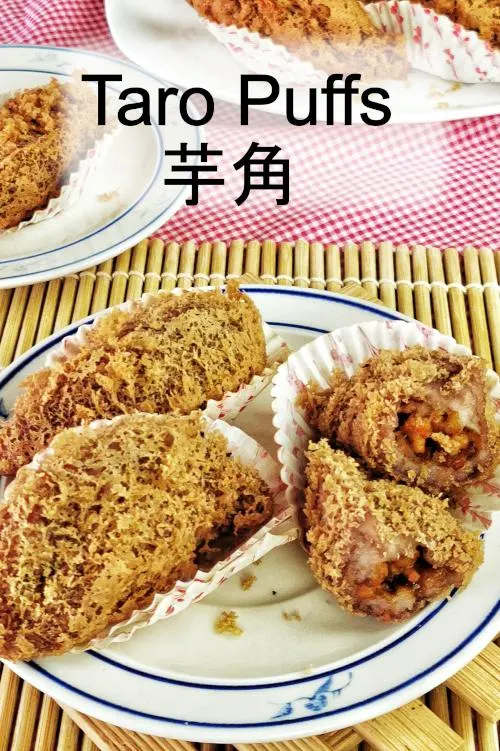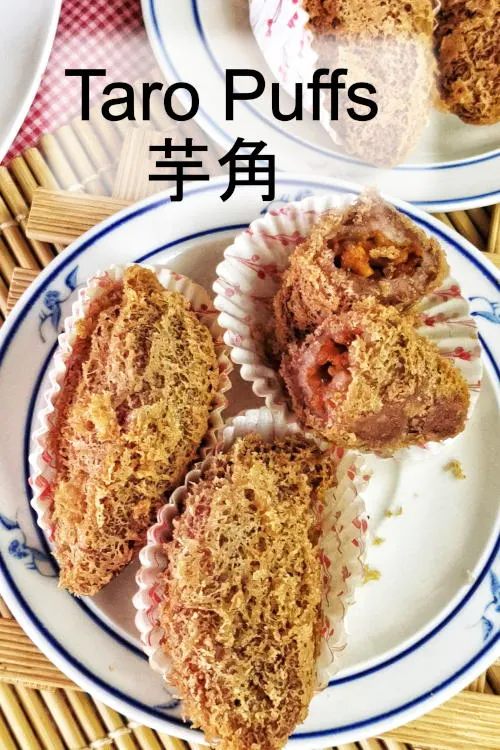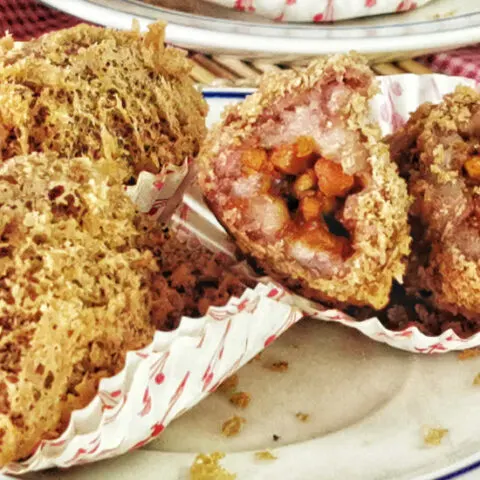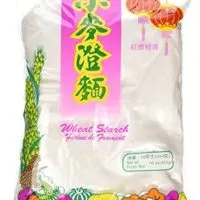A classic Hong Kong dim sum, taro puffs (wu gok, woo kok, taro dumpling) is the beloved snack catching everyone’s attention during yum-cha time.
The traditional dim sum shop will put it in a pushcart with a glass window, stacked up with char siu bao, shumai, and the best deep-fried dim sum of all, taro puff.
When the dim sum lady trundles the cart through the narrow aisle of marble tables and antique chairs, you will recognize those puffed-up, honeycomb-like golden balls with crispy surfaces and soft and creamy taro paste breath from afar.
Here is the recipe for how to make it at home. It is not difficult. The only part that needs more attention is the oil temperature while deep-frying. This step is crucial to be successful in making taro puffs.
Note: This post may contain affiliate links. Please read my privacy policy for more info. I may receive commissions for purchases made through links in this post. As an Amazon Associate, I earn from qualifying purchases.

1. Prepare the stuffing
- Soak the dried shrimp to rehydrate, then coarsely chop and set aside.
- Cut the pork shoulder and shrimp into small pieces (about the size of sweet corn). You can use pork shoulder for making taro puff stuffing. Otherwise, get some ground pork with fats from the butcher for your convenience.
- Soak the dried shiitake mushrooms with water until soft. Remove the stem, then cut it into small dice.
- Heat the peanut oil in a pan.
- Stir-fry the minced pork, followed by the dried shrimps and shrimp in the wok over medium heat.
- Add the mushrooms.
- Season with oyster sauce, ground white pepper, dark soy sauce, sugar, and salt.
- Add the 1/4 cup of water to the pan. Bring it to a boil.
- Prepare the cornstarch slurry with 2 teaspoons of cornstarch and 2 tablespoons of cold water. Thicken the stuffing with the cornstarch slurry.
- Finally, add the sesame oil to the meat mixture, give it a few stirs, then remove it from heat.
- When it is back to room temperature, refrigerate for three hours before using it as the stuffing for the taro puffs.
Note:
- Some prefer adding sweet turnip 菜脯 in small dice for extra flavor, while others may include green peas, green onions, and carrots. The ingredients in this recipe are the basic savory filling that you will find in most Cantonese dim sum restaurants.
- As for the seasoning, you can also add some light soy sauce or some chicken bouillon to enhance the taste.
2. Prepare the pastry
- Cut off the skin of the taro.
- Cut the taro into thin slices, about one inch in size and half-inch thick.
- Steam the taro over high heat for thirty minutes. It is done if you can mash it with a fork.
- Place the taro in a mixing bowl, and mash it until it becomes a soft paste without lumps.
- Measure the wheat starch in a separate bowl.
- Pour 150ml of hot water, preferably boiling, into the wheat starch and stir until it turns into a sticky mass. The heat will cook and gelatinize the starch, which is crucial to making the taro puffs expand during deep-frying.
- Add mashed taro to the wheat starch and mix until homogeneous.
- Season the taro mixture with five-spice powder, salt, and ground white pepper.
- Finally, add the lard and butter and thoroughly mix.
- Transfer the dough to a container with a cover or wrap it with cling wrap, then refrigerate two hours before use. The dough will become firmer to handle after being refrigerated.
Note:
- Lard is the most common oil to make taro puffs. However, you can make it pork-free by substituting it with shortening or butter. I use part lard and part butter in this recipe. I have also seen some recipes that use coconut oil to make taro puffs.
- You also can add a small amount of ammonium bicarbonate (known as 臭粉 in Cantonese). It is a leavening agent that helps to create a honeycomb-like exterior. However, it is hard to get outside Asia, and even only sold in certain specialties here in Malaysia. You can omit it or substitute it with baking soda.
- Wheat starch is sold in most Asian grocery stores.
3. Shape the taro puffs
- Remove from the fridge, knead the dough for a minute, then shape to form a long strip. Portion the dough to about 40g each.
- Roll the dough into the shape of a ball, then use your palm to flatten it, then press the center down to form the shape of a shallow bowl, about three inches in diameter.
- Add sufficient stuffing to the center of the ‘bowl.’ The amount of filling is 15g for the dough of 40g. Fold into a half-moon shape and pinch tightly to close the puff.
Note:
- The wrapped taro puffs are suitable to be refrigerated a few days before deep-frying.

4. Deep-fried
- Bring the oil to medium-high heat, about 170°C/340°F, with a kitchen thermometer. You can also throw a small portion of the dough into the oil. The temperature is suitable for deep frying when the dough is intact and does not fall apart, and it floats to the top in a few seconds.
- You need to make sure the oil temperature is correct, or the crispy crust that looks like spider webs won’t form. Also, make sure to use enough oil, which is enough to submerge the taro puffs fully for even cooking.
- Place the taro puffs in a slotted spoon, and lower them into the oil slowly until they are submerged in oil.
- Deep-fry the taro puffs until golden brown.
- Remove and palace it on paper towels to absorb the excess oil.
- Serve immediately while the taro puffs are crispy.
Note:
- The oil temperature is crucial. The puff will quickly fall apart if the oil temperature is too low. On the other hand, it will turn brown too fast, and the spider web texture does not develop if the temperature is too high. Please refer to the image below.
- I suggest using a wok or a heavy-bottom pot to deep-fry the taro puffs.
- I prefer using a large slotted spoon over a wire mesh strainer to deep-fry the puffs. The puffs are easier to stick to the wire mesh while frying.
Tips:
- It can be challenging to maintain the temperature of the oil. The most practical way is to deep-fry one taro puff first and observe the number of bubbles rising around the puff. I usually prefer to lower the puffs into the oil very slowly and raise the slotted spoon upwards to reduce the temperature if too many bubbles are rising around the puffs. It is not easy to describe in words, so please refer to the video for the actual demonstration.
Here’s how to freeze uncooked woo kok:
Once you have filled and shaped the taro puffs into an oval shape, place them on a tray lined with a baking sheet. Next, please keep them in the freezer until they are firm. Then, you can transfer them to a freezer bag to keep as they will no longer stick together. I can be kept for up to a month.
Other recipes related to taro puffs
You can try making the following snacks and dim sum if you like taro puffs.
- Our spring rolls are light, crispy, and airy and shatter in your mouth when you bite on them. This recipe is a classic that everyone likes.
- Shumai is an open-end dumpling with meat and shrimp paste wrapped with a thin pasty skin. It has remained my favorite Dim Sum through the years.
- Find out how to make shrimp dumplings (har gow) with the exact taste you expect from the Chinese restaurant.

Taro puffs - How to make woo kok / 芋角 at home
A classic Hong Kong dim sum, taro puff (wu gok, woo kok, taro dumpling) is the beloved snack catching everyone's attention during yum-cha time.
Here is the recipe for how to make it at home. It is not difficult. The only part that needs more attention is the oil temperature while deep-frying. This step is crucial to be successful in making taro puffs.
Ingredients
Ingredients A (filling)
- 1 tbsp vegetable oil
- 25g shrimps
- 100g pork shoulder
- 5g dried shrimps
- 2 dried shiitake mushrooms
Ingredients B (seasonings for filling)
- 2 tbsp oyster sauce
- 1/4 tsp ground white pepper
- 2 tsp dark soy sauce
- 1 tsp sugar
- 1/2 tsp salt
- 1/4 cup water
- 2tsp cornstarch
- 1 tsp sesame oil
Ingredients C (pastry)
- 120g wheat starch
- 150ml water
- 1 tsp salt
- 1 tsp Chinese five-spice powder
- 1/2 tsp ground white pepper
- 300g taro
- 30g butter
- 40g lard
- 1/2 tsp baking soda
- Additional oil for deep-frying
Instructions
Prepare the stuffing
- Stir-fry the minced pork with oil, then coarsely chopped dried shrimps, shrimp, and mushrooms dice in the wok over medium heat.
- Season with oyster sauce, ground white pepper, dark soy sauce, sugar, and salt.
- Add the 1/4 cup of water to the pan. Bring it to a boil.
- Thicken the stuffing with the cornstarch slurry.
- Finally, sit in sesame oil to the meat mixture, then remove it from heat.
- Refrigerate for three hours before use.
Prepare the pastry
- Cut the taro into thin slices, about one inch in size and half-inch thick.
- Steam the taro over high heat for thirty minutes.
- Mash it until it becomes a soft paste without lumps.
- Pour 150ml of hot water, preferably boiling, into the wheat starch and stir until it turns into a sticky mass.
- Add mashed taro to the wheat starch and mix until homogeneous.
- Season the taro mixture with five-spice powder, salt, and ground white pepper.
- Finally, add the baking soda, lard, and butter and thoroughly mix.
- Refrigerate two hours before use.
Shape the taro puffs
- Remove from the fridge, then portion the dough to about 40g each.
- Flatten the dough to form a disc shape.
- Add 15g of the filling and fold into a half-moon shape.
Deep-fried
- Place the taro puffs in a slotted spoon, and lower them into the oil (170°C/340°F) slowly until they are submerged in oil.
- Deep-fry the taro puffs until golden brown.
- Remove and palace it on paper towels to absorb the excess oil.
Notes
- You can substitute butter with lard or shortening.
- Use chicken breast meat if you like.
- The weight of taro is after removing the skin.
Recommended Products
As an Amazon Associate and member of other affiliate programs, I earn from qualifying purchases.
-
 Frontier Five Spice Powder, 1.92-Ounce Bottle
Frontier Five Spice Powder, 1.92-Ounce Bottle -
![Enther Meal Prep Containers [20 Pack] Single 1 Compartment with Lids, Food Storage Bento Box | BPA Free | Stackable | Reusable Lunch Boxes, Microwave/Dishwasher/Freezer Safe,Portion Control (28 oz)](https://tasteasianfood.com/wp-content/uploads/2019/06/71oizUojyDL._SY355_-200x200.jpg.webp) Enther Meal Prep Containers [20 Pack] Single 1 Compartment with Lids, Food Storage Bento Box | BPA Free | Stackable | Reusable Lunch Boxes, Microwave/Dishwasher/Freezer Safe,Portion Control (28 oz)
Enther Meal Prep Containers [20 Pack] Single 1 Compartment with Lids, Food Storage Bento Box | BPA Free | Stackable | Reusable Lunch Boxes, Microwave/Dishwasher/Freezer Safe,Portion Control (28 oz) -
 ThermoPro TP03A Digital Instant Read Meat Thermometer Kitchen Cooking Food Candy Thermometer for Oil Deep Fry BBQ Grill Smoker Thermometer
ThermoPro TP03A Digital Instant Read Meat Thermometer Kitchen Cooking Food Candy Thermometer for Oil Deep Fry BBQ Grill Smoker Thermometer -
 Wheat Starch, 16 Ounce
Wheat Starch, 16 Ounce
Nutrition Information:
Yield: 15 Serving Size: 1Amount Per Serving: Calories: 143Total Fat: 8gSaturated Fat: 3gTrans Fat: 0gUnsaturated Fat: 5gCholesterol: 17mgSodium: 377mgCarbohydrates: 14gFiber: 1gSugar: 0gProtein: 3g
This data was provided and calculated by Nutritionix on 13/4/2022

David Lum
Monday 2nd of June 2025
Looking forward to trying your wu gok recipe. Is there a reason why the 5 spice and ammonium carbonate or baking soda isn’t whisked into the wheat starch before adding the boiling water?
KP Kwan
Wednesday 11th of June 2025
Sorry for the late reply. I just want to be sure the baking soda is effective, since it can rapidly decompose in boiling water and lose its leavening power.
Carole Groves
Friday 5th of April 2024
Please enjoy Nepal! When you return, please could you note what amount of fresh shrimp is equal to 5mg dried shrimp. I have fresh mushrooms and fresh shrimp, but I can’t get dried goods here.
B Young
Friday 18th of November 2022
In reading through your recipe, I can tell that the taro puffs will taste great. Your ingredients are very authentic. I do have a question about cooking after freezing. Do I let the puffs thaw before I fry?
KP Kwan
Saturday 19th of November 2022
I have not tried to deep fry the frozen Taro puffs. If I based on my experience of other frozen ingredients being fried, then I would say that you do not need to defrost the puffs. Since I am not entirely sure of the answer, I look forward to knowing your result too :)
Yola
Thursday 23rd of June 2022
Hello I follow your recipe stéphanois by stéphanois And the result is not like yours
KP Kwan
Thursday 23rd of June 2022
I suggest you look at the video and let me know the difference. Then, hopefully, I can help to identify what happened.
ong kean lim
Thursday 14th of April 2022
Can I bake it instead of deep frying? If so, what temperature and time to use. Thanks
ong kean lim
Thursday 21st of April 2022
@KP Kwan, Thank you KP. I love Taro but find deep frying not so healthy, especially I am a senior who is over 80. Also, deep frying uses a lot of oil and with the cost of cooking oil going up that makes me avoiding deep fried food. I hope to have some baking recipes from you if it is possible. Thank you and stay safe
KP Kwan
Thursday 14th of April 2022
I never tried baking it. Really not sure. I have some doubts as I have not seen any baked taro puff recipe.